With the signings of Achraf Hakimi and Gianluigi Donnarumma from Serie A cornerstones Internazionale and AC Milan respectively, Sergio Ramos from La Liga giants Real Madrid, Georginio Wijnaldum from the EPL’s Liverpool, and the permanent signing of Danilo Pereira from Porto, The Athletic’s Adam Crafton declared that Paris Saint-Germain “already thought they’d won the transfer window”. After then going on to add out-of-contract Lionel Messi to their shopping cart, the reporter stated that Les Parisiens “think they’ve won the lottery”.
Mauricio Pochettino, who arrived at Le Parc des Princes in January after the French club parted ways with eventual 2020/21 UEFA Champions League winner with Chelsea Thomas Tuchel, has got a star-studded squad to play around with as he attempts to achieve PSG owner QSI’s “all-consuming” ambition of bringing the Champions League trophy to Paris for the very first time, and his hefty backing in this summer’s transfer market is unlikely to ease the pressure or expectations, with Les Parisiens coming off the back of a season where they not only dropped out of Europe’s elite club competition in the semi-final versus Manchester City but also failed to win Ligue 1, only managing to finish second to Christophe Galtier-led Lille.
In 2016, ahead of his first EPL meeting with a manager who, needless to say, had a massive impact on PSG’s new star Messi in the earlier part of his career – Pep Guardiola – Pochettino listed himself alongside the Man City boss in the bracket of a “new era” of managers who combine modern technology with a “romantic vision of football”. There’s evidently plenty of mutual respect between Poch and Pep but Pochettino also made it clear that back then, it was difficult to compare him to Guardiola due to the difference in opportunities that had been presented to the two men, saying: “The most important thing is that if you have the possibility, you take it” – referring to achieving success.
With his current side, which includes Messi, there’s no doubt that Pochettino has a talented enough squad at his disposal to compete with the best. Now, the question is: How will the Argentinian tactician use his set of luxury tools to unlock PSG’s path to European glory? Ultimately, it’s very difficult to say – there are a lot of intriguing options available to the manager. However, in this tactical analysis piece and scout report, we put ourselves in the 49-year-old’s shoes and theorise how his squad will look in terms of shape, tactics, and cohesion. Our tactical analysis uses data, video analysis, and concepts of tactical theory to provide a deep dive into different players’ potential roles in this squad and look at how Pochettino might try to get this team that’s been dubbed “The Harlem Globetrotters of football” to function as a title-winning unit.
The backline
Throughout his time at PSG, and his career in general, Pochettino has preferred a system with two centre-backs – mainly the 4-2-3-1 – over a system with three centre-backs. This preference has continued into the 2021/22 season so far and we’re going forward with the belief that Pochettino intends to use something like a base 4-2-3-1 template with his team.
The personnel will, of course, naturally change depending on the opponent and situation. We feel there’s a strong chance that Pochettino will opt to either play with three centre-backs against tougher opponents or sacrifice an attacker for a more defensive-minded midfielder.
New signing Hakimi walks into the starting XI based on the fact that PSG’s primary right-back last season, Alessandro Florenzi, is no longer at Le Parc des Princes.
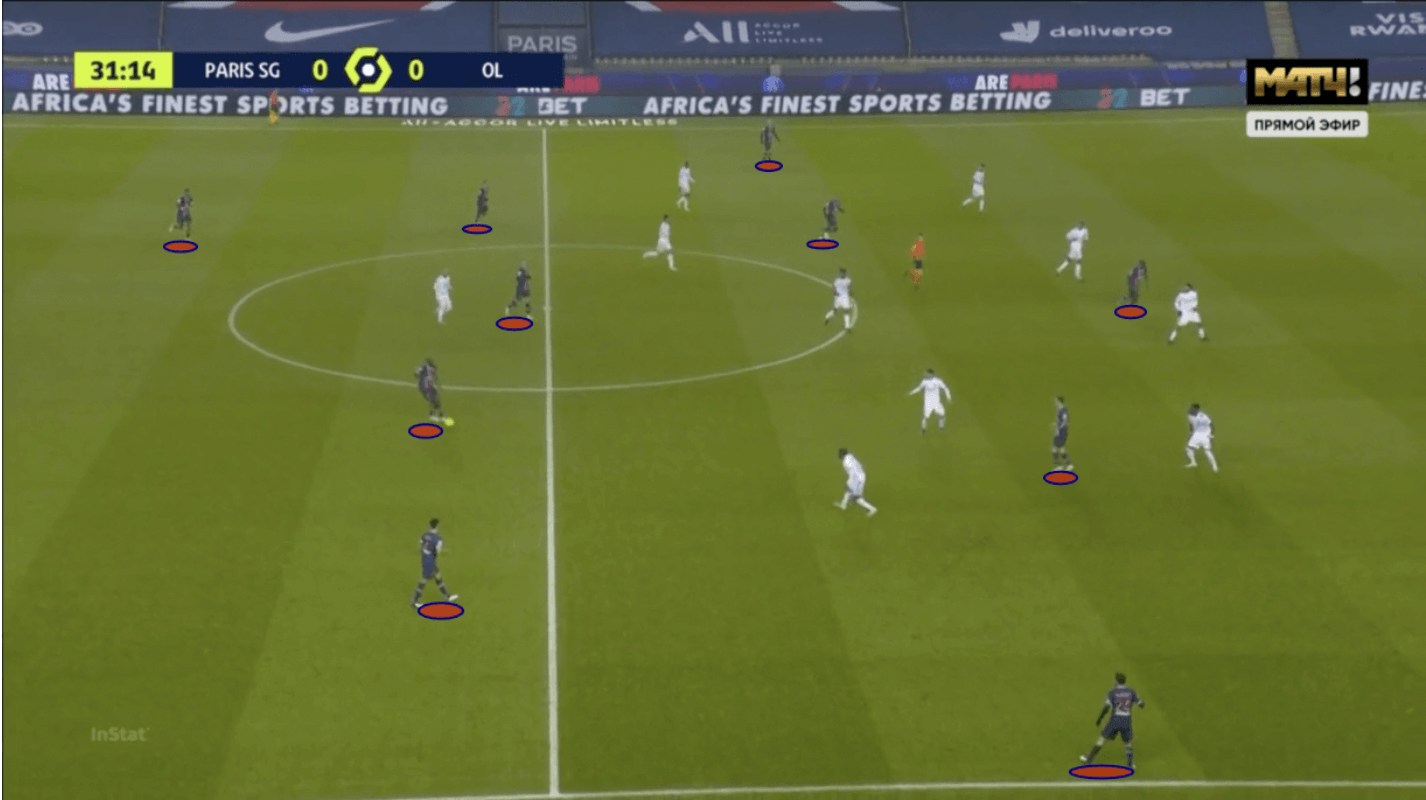
In figure 1, we see PSG building an attack during the 2020/21 season. As was common for Les Parisiens, the opposition have packed the centre of the pitch with bodies, leaving lots of space on the wings. This space is generally reserved for PSG’s full-backs. One of PSG’s issues last season was that they failed to take advantage of this space enough.
On occasions, they crossed to no avail from wide areas. This can partly be attributed to the fact that they didn’t have a significant physical presence in the box to take advantage of Florenzi’s high crosses. They failed to create playmaking opportunities that could take advantage of their attackers’ array of strengths. By packing the centre and forcing them to play through the wings, PSG’s opponents took away their ability to play through the lines and exposed a weakness.
Another issue of PSG’s last season was that in situations like figure 1, the centre-backs sometimes passed to the full-back’s trailing leg as opposed to in front of him. This slowed PSG’s build-up and forced Florenzi to simply play the ball backwards, continuing the circulation of possession without penetration.
Florenzi received a lot of progressive passes last season. Per FBref, he ranks in the 82nd percentile among players in his position from the top-five leagues and European competition for progressive passes received per 90 over the last calendar year. This highlights how much PSG tried to progress through the full-backs last season.
With the Italian right-back opting for more negative passing options on occasion, he’s made 3.52 progressive passes per 90 in the last year – ranking him in the 43rd percentile – and 3.78 progressive carries per 90, ranking him in the 30th percentile.
PSG also had a glaring weakness in the full-back positions when it came to defending aerially last season, with Florenzi often getting exposed at the back post, and opposition sides targeting this weakness via crosses. Florenzi managed to win just 29.5% of his aerial duels in the last year.
Enter Hakimi, who may represent an improvement for PSG in many of the above problem areas.
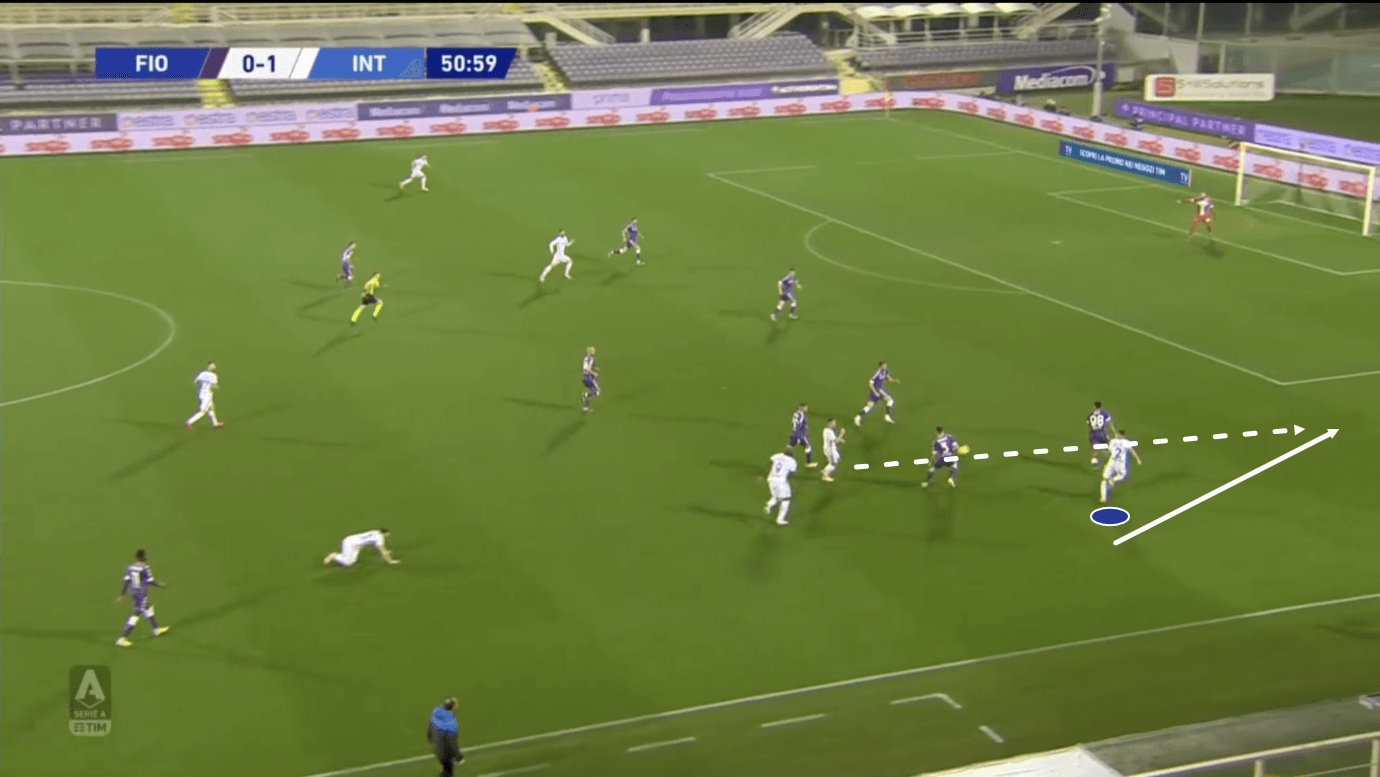
Hakimi will thrive with space on PSG’s right-wing. With more advanced players on this side of the pitch like Messi and Di María attracting the opposition’s left-back inside, expect the sight in figure 2 to be a common one in Paris this term. Hakimi’s very quick and is good at taking advantage of space in wide areas. He’s comfortable providing the width in the final third and he’s good at driving behind the opposition’s final line via late runs. He likes to be at top speed by the time he reaches the backline. This makes him very difficult to defend against, as no opposition left-back is realistically going to match him for speed going from a starting position.
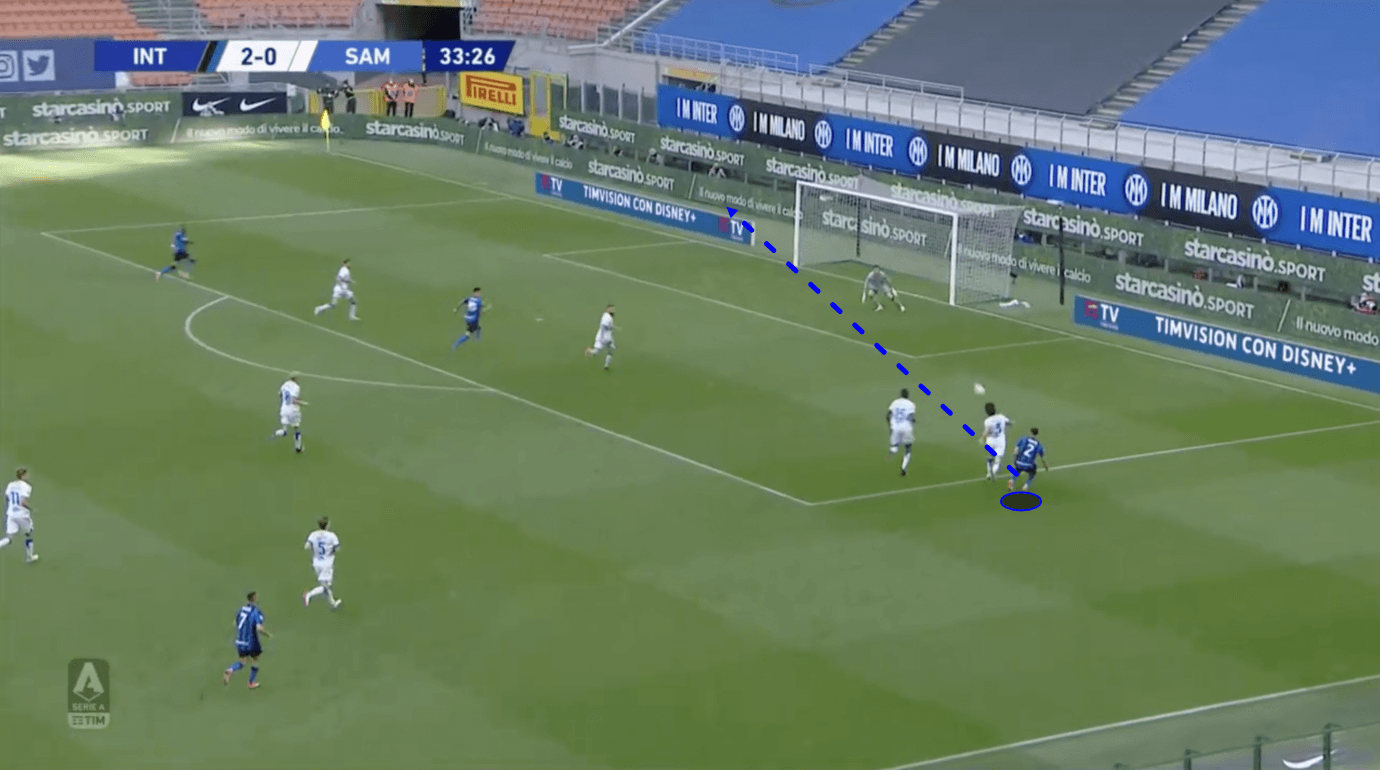
Hakimi loves to drive into the opposition’s box and cross from advanced positions. It’s common to see him driving to the byline before pulling the ball back or getting into positions like we see him occupying in figure 3, on the edge of the penalty area from where he can float mid-height balls across the face of goal into the path of onrushing attackers. He loves to put backspin on his crosses, making them almost look like little chipped balls into the box. This can take some pace out of the ball to tee it up nicely for the forwards.
Against organised, compact defences like the one we saw in figure 1, expect to see Hakimi dribbling quite a lot to try and beat opposition defenders or attract them towards him, creating space for others that way. However, we may really see the best of him on counter-attacks where he can run in behind a defence and float crosses into the box, like in figure 3.
Similar to Florenzi, Hakimi also received a lot of progressive passes last season. He’s received 5.58 per 90 over the last year, ranking him in the 97th percentile, highlighting his familiarity with playing this important, progressive role in possession. However, Hakimi fares better than Florenzi in terms of what he does with the ball. The Moroccan ranks in the 60th percentile for progressive passes (4.02 per 90) and the 94th percentile for progressive carries (7.52 per 90). So, expect a better ball progressor on PSG’s right-wing this season in the form of Hakimi, and fewer instances of the build-up stagnating as it moves to the full-back.
Hakimi will not fix PSG’s aerial defending issues, but he does represent a potential improvement over Florenzi, as he has won 36.4% of his aerial duels in the last year.
With Marquinhos occupying the right centre-back position, we expect a new partnership to form with Ramos. The Spaniard’s fitness levels are questionable at present, so the number of minutes he’ll be able to play is uncertain. Will it be possible to switch Kimpembe and Ramos depending on the fixture? Will this kind of rotation disrupt harmony in the backline? These are questions the Argentinian manager must consider, however, purely looking at the quality of options available, there’s no doubt for us that Ramos is the superior centre-back – his availability could be the all-important factor, though.
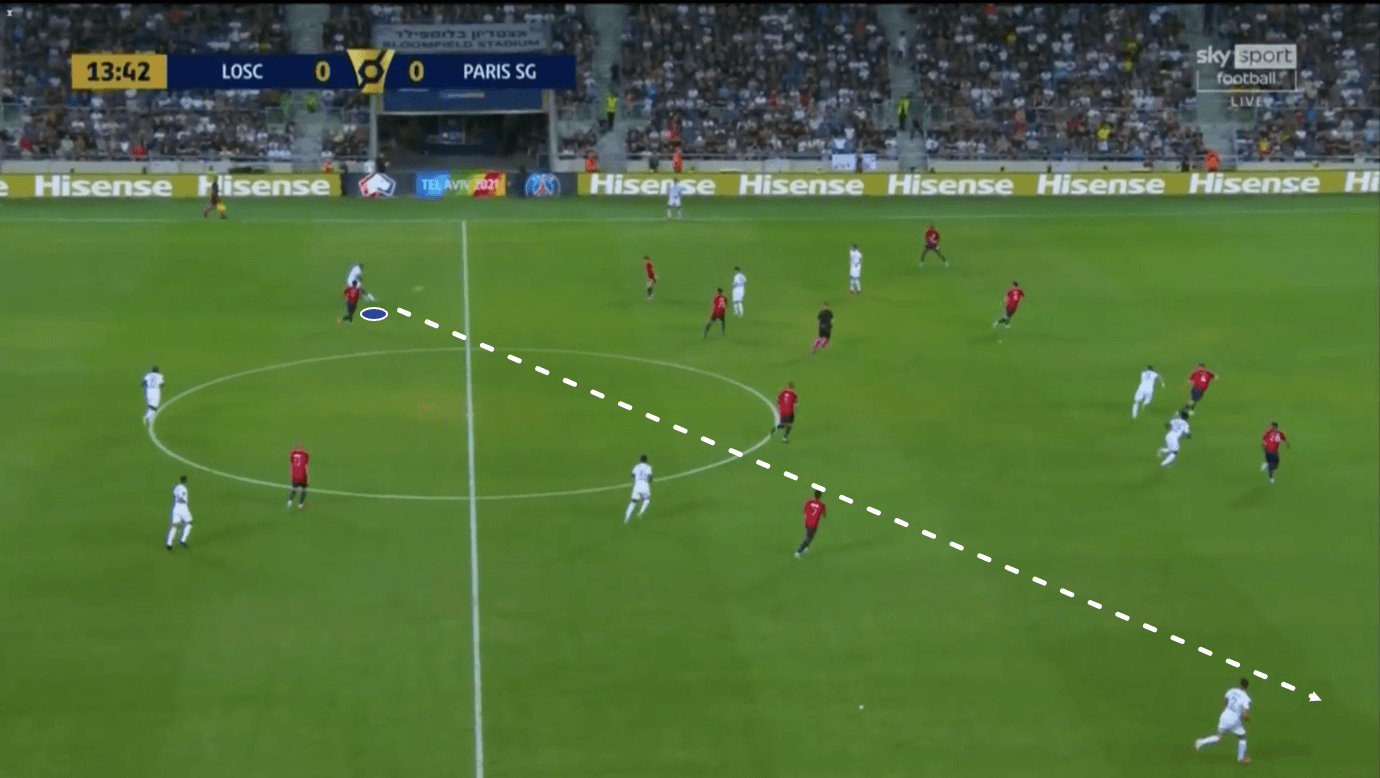
In build-up, it’s common to see the ball played back to PSG’s nearest centre-back from a midfielder or the full-back on that wing. Then, with the opposition attracted to that side and quite compact, the opportunity to play a switch to the full-back on the opposite wing is on. We see an example of Kimpembe playing this switch to release Hakimi in figure 4. Expect Les Parisiens to try and make this switch from the left centre-back to the right-back on the underloaded side quite frequently this season, it will likely be an important part of the left centre-back’s role in possession.
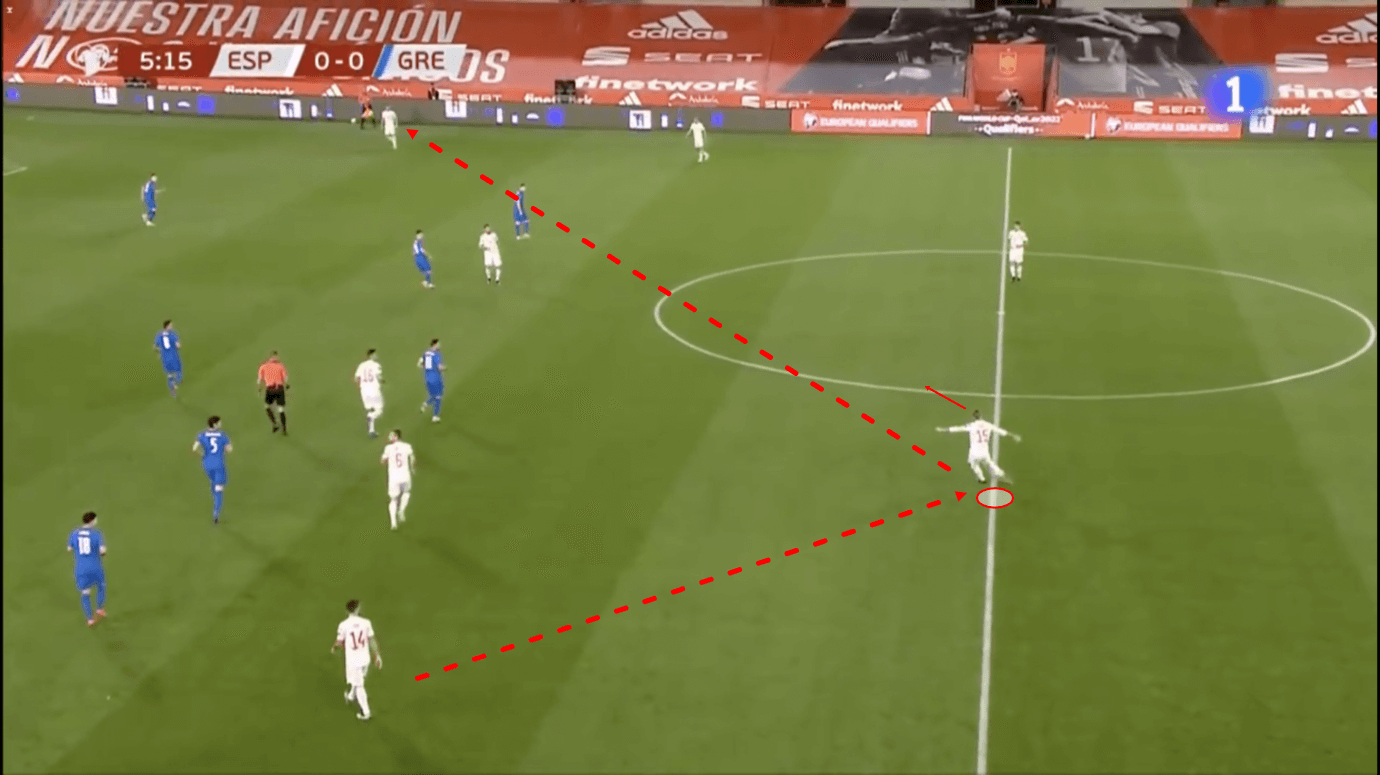
Kimpembe is a natural left-footer which helps him to pull off this pass even when pressed by the nearest opposition centre-forward on the inside, as we saw in figure 4. However, though Ramos is right-footed, he’s very familiar with playing on the left and this long switch to the opposite wing, which we see in figure 5. Ramos tends to be very composed in possession. He’s comfortable under pressure, scans well before and while receiving the ball to assess his options, and is a quick decision-maker who can pull this switch off quickly when required.
It will be difficult for him when pressed from the inside, but PSG have got the quality at centre-back and in midfield to potentially find solutions should that problem present itself. The two left centre-back options create different dynamics for the team based on several factors – including the preferred foot – and this is something for Pochettino to consider.
The numbers would indicate that there are plenty of reasons to choose Ramos, if available, based on quality. Firstly, Ramos is a more accurate long passer than Kimpembe. Per Wyscout, the Spaniard has 77.36% long pass accuracy for the last calendar year from 7.04 long passes per 90, compared to Kimpembe’s 59.09% accuracy from 1.45 long passes per 90. Considering the potential importance of this switch to Hakimi moving forward, Ramos’ long pass familiarity and accuracy could be crucial.
Ramos has also played 10.55 progressive passes per 90 in the last year, with 81.76% accuracy, while Kimpembe has played 7.16 per 90 with 81.57% accuracy. So, they have a similar success rate with progressive passes but Ramos tends to play far more, which could be a result of his increased comfortability on the ball compared to Kimpembe, who tends to receive the ball more nervously, with less prior scanning, often resulting in sideways or backwards passes.
The two defenders have engaged in a similar number of defensive duels per 90 in the last year – 4.98 for Ramos and 4.95 for Kimpembe – but Ramos has achieved a 72% success rate while Kimpembe has achieved a 66.67% success rate. Meanwhile, Ramos has made 7.6 PAdj interceptions in the last year to Kimpembe’s 6.26.
Overall, we feel that Ramos – should he get back to speed relatively quickly following his injury layoff – represents a considerable upgrade in many key areas over Kimpembe, both defensively and offensively, and will likely start alongside Marquinhos in PSG’s backline, potentially forming a dangerous relationship with fellow new signing Hakimi at right-back and fellow Spaniard Juan Bernat at left-back.
Midfield
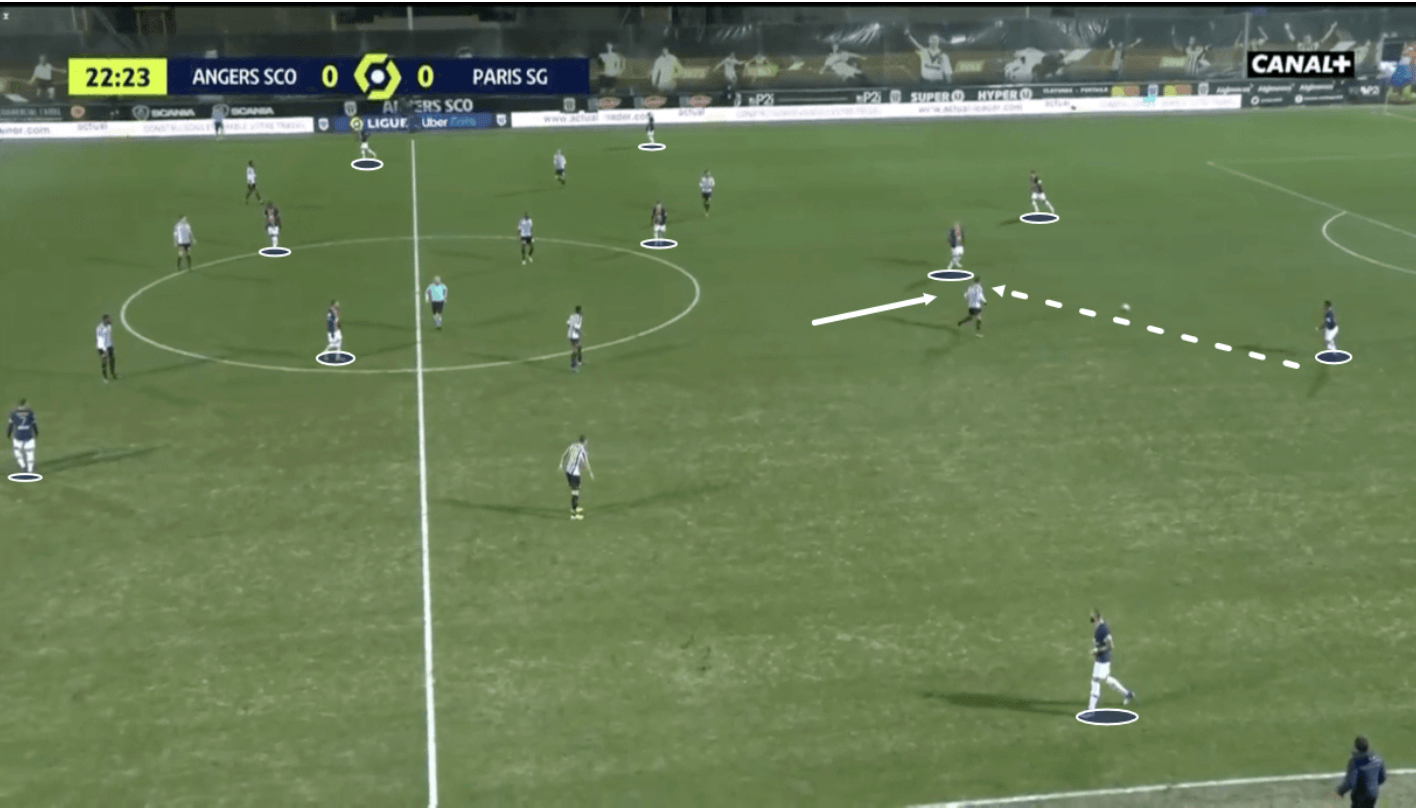
In figure 6, we see PSG building an attack last season. Here, we see the full-backs threatening to stretch the opposition via their positioning out wide, and one midfielder dropping between the centre-backs to help progress play. Often, under both Pochettino and Tuchel, Leandro Paredes was tasked with performing this role in build-up of being the deeper-lying midfielder. We feel he should continue doing so, as he’s elite at it and by performing this role, he allows the man who we believe will partner him in midfield – Marco Verratti – freedom to influence the game further upfield.
Paredes and Verratti are PSG’s most progressive passers, with Gueye and Herrera, respectively, coming next in line and also performing well in this area – just not as well as these two. Paredes played 12.24 progressive passes per 90 in Ligue 1 last season, with 87.17% success, while Verratti played 11.79 progressive passes with 89.86% success. You could make a case for Verratti to play as the deeper midfielder, but given his ability to influence the game when playing further upfield, we feel that Paredes is a great option for this role and a great partner for Verratti. Playing this midfield duo will help PSG to get the ball into the feet of their attackers as quickly as possible, and in dangerous areas, which will help to maximise the threat of their luxury forward line.
Among midfielders in the top-five leagues this past year, Paredes ranks in the 98th percentile for passes completed, 93rd percentile for progressive passes, as well as the 98th percentile for aerials won, the 83rd percentile for successful pressures and the 71st percentile for interceptions – all of which are solid-to-elite numbers in what will likely be important areas for PSG’s deepest-lying midfielder.
Paredes performs less impressively in progressive carries, and much less impressively in terms of deep completions (a non-cross pass that is targeted to the zone within 20 meters of the opponent’s goal) and shot-creating actions, however – which is where Verratti comes in.
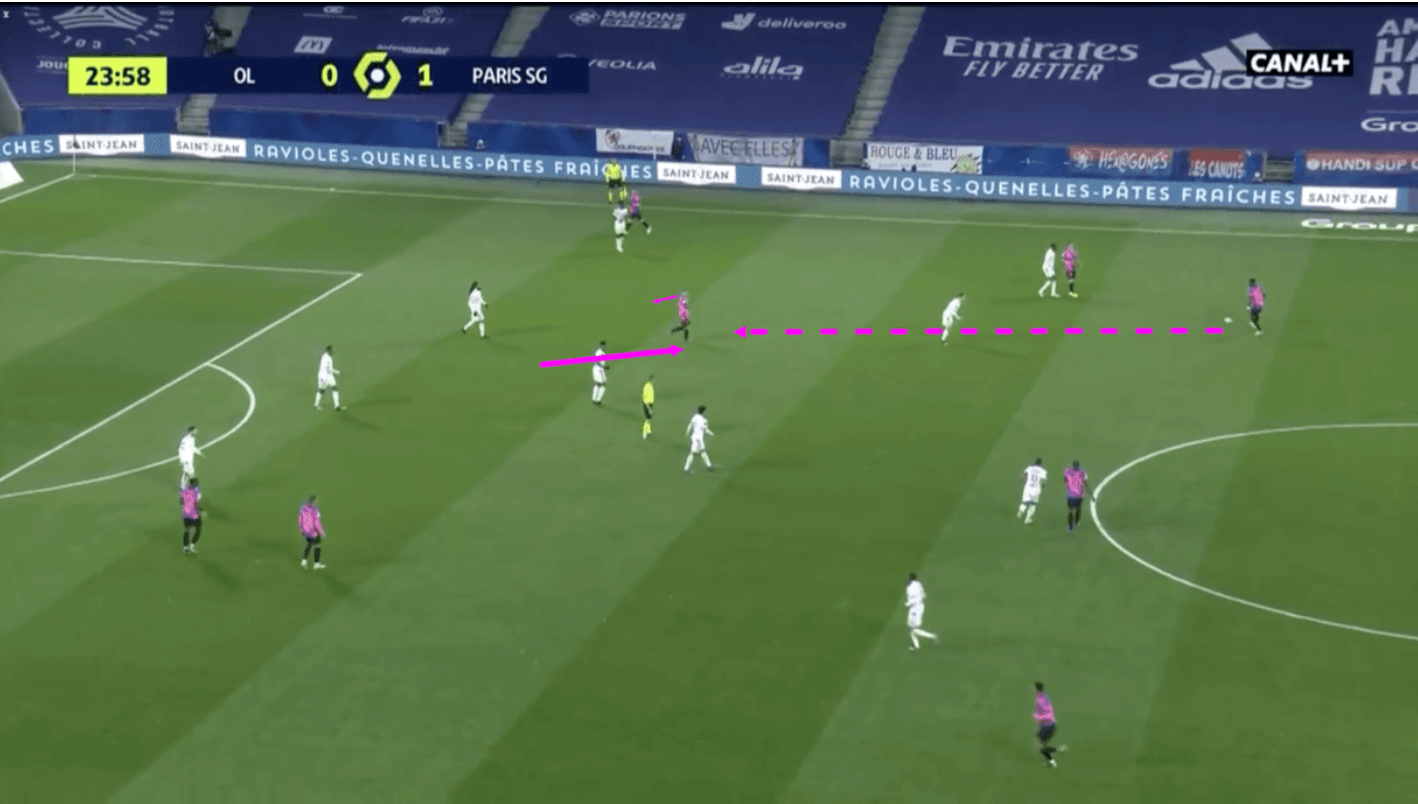
Verratti was sometimes deployed even as a ‘number 10’ by Pochettino last season, which is depicted in figure 7, and the Italian performed this role very effectively. Verratti is simply a very intelligent player who’s constantly scanning and making threatening movements into space where he can receive progressive passes – again, depicted in figure 7. This is why he’s so useful in advanced areas and why he can partner up well with Paredes. In build-up, Verratti can sit in a central midfield position while Paredes drops into the backline. From there, Paredes will have his pick of who to pass to and Verratti is likely to be a very good option a lot of the time.
The EURO 2020 winner made 1.94 deep completions per 90 in Ligue 1 last season – more than any PSG midfielder except for Julian Draxler who frequently played as a winger – while he played 2.22 through passes per 90 – more than any PSG midfielder bar Paredes. He also engaged in more offensive duels per 90 (11.22) than any Paris midfielder except for Rafinha, and did so with a solid 45.69% success rate.
Verratti ranks in the 99th percentile for progressive carries in the last calendar year and the 90th percentile for shot-creating actions. For reference, Paredes ranks in the 73rd percentile for progressive carries and the 32nd percentile for shot-creating actions. This isn’t to show a disparity in quality between the two players, but to highlight their very different profiles and how they can work together. Paredes can contribute in build-up and ball progression, while Verratti can contribute in ball progression and chance creation. Paredes will play a big part in getting the ball forward, while Verratti will play an important part in helping his side to break teams down via his movement and passing.
Defensively, Verratti also offers a lot to his side – he made more successful defensive actions per 90 in Ligue 1 (11.51) than any other PSG midfielder last season. He ranks in the 88th percentile for tackles won and the 92nd percentile for pressures in the attacking third – which could see him play an important part in Pochettino’s typically aggressive pressing tactics behind a forward line that may require some assistance. Expect PSG to try and win the ball back quickly via counter-pressing, but if they fail to do so quickly, then quickly drop back into an organised shape. They likely won’t continue to press aggressively for long periods when Messi and Mbappé, who we’ll come to later, are not active defenders, but can present a lethal counter-attacking threat if the opposition are drawn upfield with PSG defending deeper.
The front four
PSG’s front four essentially pick themselves, unless Pochettino opts for the safe option in a bigger fixture, or when holding onto a lead, and opts to drop one of the front four for a holding midfielder, which could then see Verratti occupy the ‘number 10’ position. Di María, Messi, Neymar, and Mbappé can offer PSG a lot of quality in attack and would certainly fit Pochettino’s “romantic vision”. So, how might this front four function?
During his time at Le Parc des Princes, Tuchel once explained in an interview with BT Sport pundit Rio Ferdinand, he will “never tell” his world-class players exactly what to do, but will allow them creativity within the confines of their defined role within his squad, saying: “It has to be like an orchestra – everybody has his role”. I feel this is a logical way of looking at how a team, in general, works, especially at this level.
This PSG squad has got quality all over the pitch with intelligent players who will come across moments in-game that they will react to. Spaces will present themselves and the likes of Messi, Neymar, Mbappé, and Di María will react to this. Pochettino’s role is to give these players the right, outlined role within his orchestra so they can use their qualities to the best of their ability when the chance to create and/or exploit space appears.
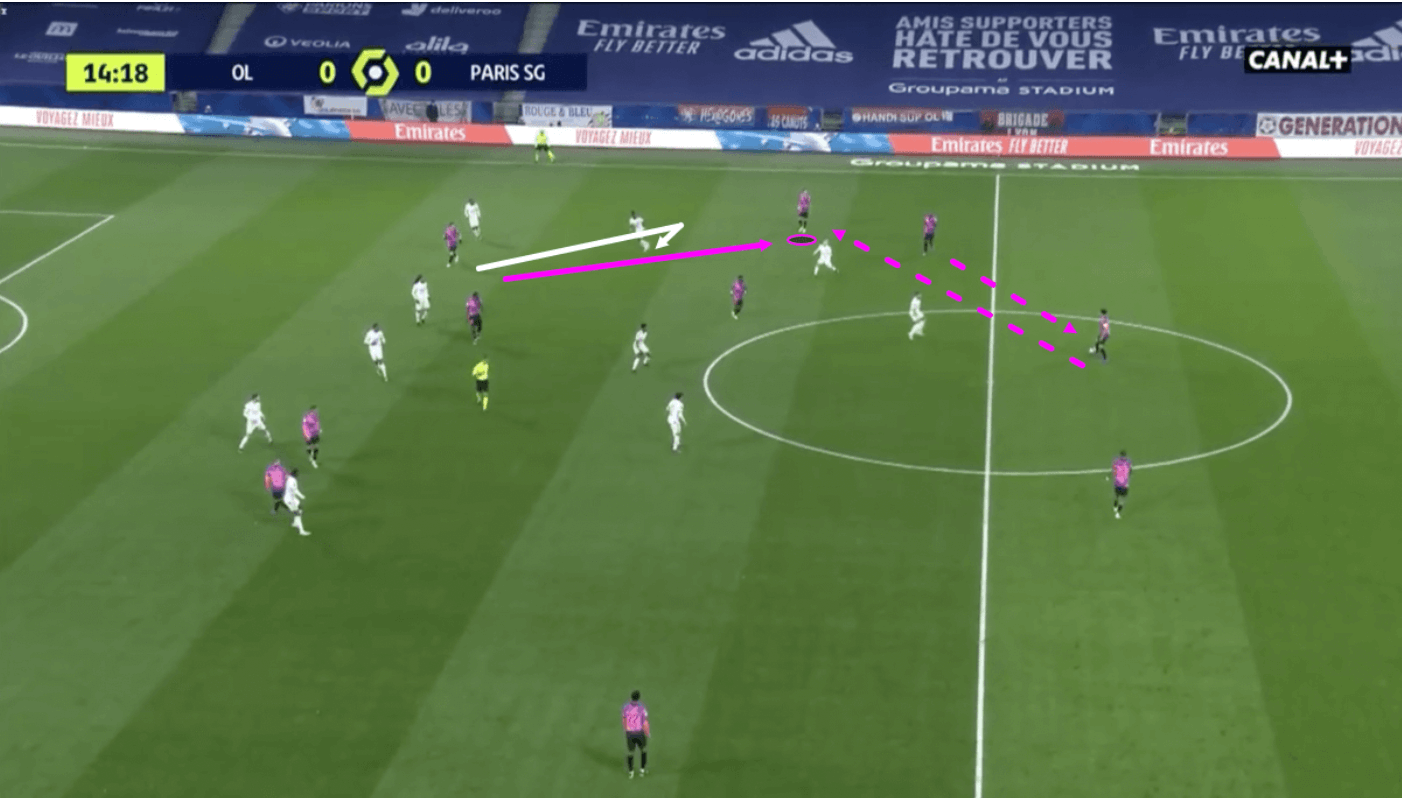
Firstly, while out of possession he may occupy a more traditional right-wing position, we expect Di María to play very centrally in possession a lot of the time, almost occupying a right central midfielder position alongside Verratti at left central midfield, in front of Paredes and the centre-backs. We see an example of how this may look in figure 8, where Verratti can be seen in a deep, right-sided position having just dropped from a more advanced position to make himself available for the teammate in possession, while also then creating space for an advanced teammate by pulling an opposition defender away.
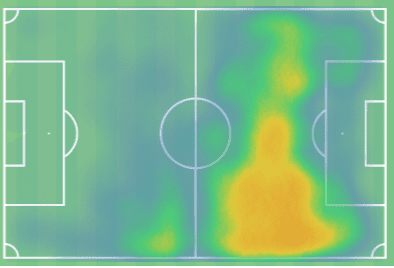
Figure 9 shows Di María’s 2020/21 heatmap, which highlights that he does already like to spend the majority of his time in the more advanced part of the middle third, as opposed to in the final third, and the right-sided central midfield position, in possession, will allow him to occupy this preferred position.
What can Di María do from here? Similar to Verratti and Paredes, the Argentinian is an elite ball progressor and will help his team in the ball progression phase, getting it into the feet of Messi, Neymar or Mbappé in the final third. Among top-five league attacking midfielders and wingers for the last year, Di María ranks in the 92nd percentile for progressive passes and the 91st percentile for progressive carries, indicating how good he is at getting the ball forward.
Di María will be a playmaker from this right-sided position like Verratti on the left, with his 97th percentile ranking for shot-creating actions and the same ranking for assists. Di María will enjoy fewer shooting opportunities from here than if he were a more advanced right-winger cutting in onto his left foot, however, he ranks in just the 17th percentile for shots on target% despite ranking in the 92nd percentile for shots and with Messi, Neymar and Di María ahead of him, it mightn’t hurt PSG to limit Di María’s shooting opportunities to promote shot efficiency.
Another important quality that Di María brings to this team is defensive work rate. Mbappé and Messi rank in the 1st percentile and 8th percentile, respectively, for pressures – they don’t offer a tonne off the ball in general and many of their defensive numbers could set alarm bells ringing for those of us who are constantly thinking about what could go wrong (though both Messi and Mbappé perform pretty well in terms of pressure success%, indicating that in short bursts of pressure like we discussed earlier, they could be helpful to PSG, provided Pochettino can draw the defensive work-rate out of them.)
Di María is a lot more active defensively, however, with a 73 percentile ranking for pressures and some pretty impressive numbers in terms of tackles. The Argentinian, along with Neymar, who doesn’t currently offer a tonne in terms of defensive output but does a lot more than Messi or Mbappé in terms of pressing and getting back into the organised structure, will have to work for their team when pressing and especially when defending deeper, otherwise, a lot of pressure will mount on PSG’s backline, but the counter-attacking threat posed by Messi and Mbappé up top could also go some way to helping in defence, as the opposition might be hesitant to commit many men forward as a result.
Di María’s combination of attacking threat and defensive work-rate make him an important cog in this side and we expect him to feature prominently in Pochettino’s PSG this season in a right-wing role out of possession and something like a right central midfield role in possession.
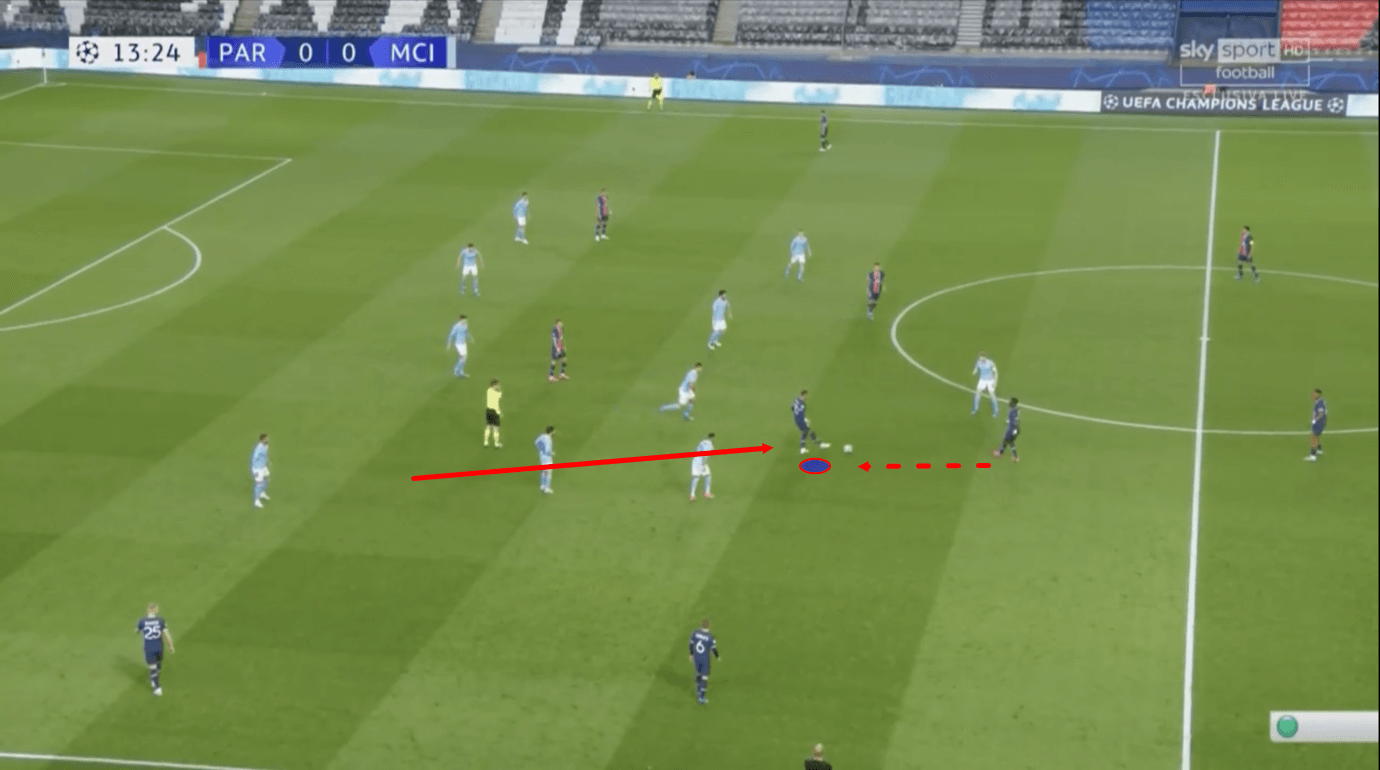
As for Neymar, we expect him to feature on the left-wing out of possession, likely occupying the left half-space, primarily, in possession. Just before figure 10, the Brazilian was in the left half-space as part of PSG’s front five with the left-back outside of him on the wing and Mbappé to his right. This is exactly where we expect him to spend most of his time this season too.
However, Neymar likes to come deep a lot during the ball progression phase, as can be seen in figure 10. He is an elite ball carrier and likes to get on the ball here before turning and dribbling forward to create some chaos in the opposition’s defensive structure. When this happened in figure 10, Verratti shifted out into the left-back position where space was open and though Neymar was prevented from turning here by Man City, he could pick out a free Verratti or link up with the right central midfielder. So, we’re now starting to see how certain tendencies of PSG’s players in terms of positioning and movement will gel together as the players react to space on the pitch.
Expect to see Neymar dropping deep like this frequently with the left-back overlapping and Verratti finding space, whether that’s the vacated left-back position or even Neymar’s vacated left half-space position. There will be heavy rotations on this left side with those three players and also Mbappé, who will likely be the ‘centre-forward’ of this team, but will favour the left far more than the right and will drop deep on occasion, potentially rotating with Neymar.
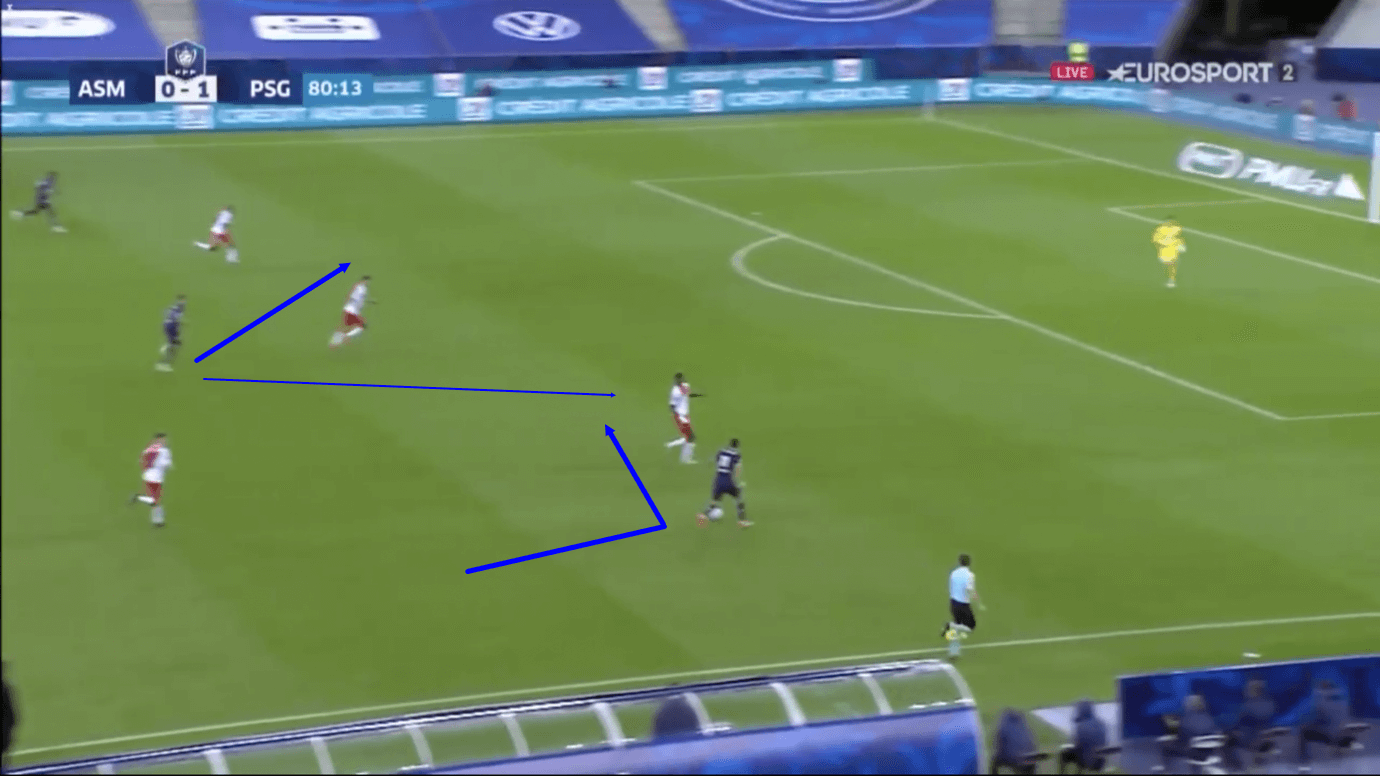
In figure 11, we see an example of Mbappé’s tendency to favour the left over the right. This is somewhat reminiscent of Thierry Henry, who, at Arsenal, was basically a left forward despite being a centre-forward on paper. In figure 11, Mbappé had the chance to use his pace to burst across the centre-back and exploit this space for Di María to play him through. Instead, he pulled off to the left and left the space inside open for Di María. Regardless of whether the ball is on the right, as was the case here, or on the left, Mbappé is always attracted to the left forward position and likes to make these types of movements out to the left from where he can cut in onto his favoured right foot, open up his body and shoot with the side foot.
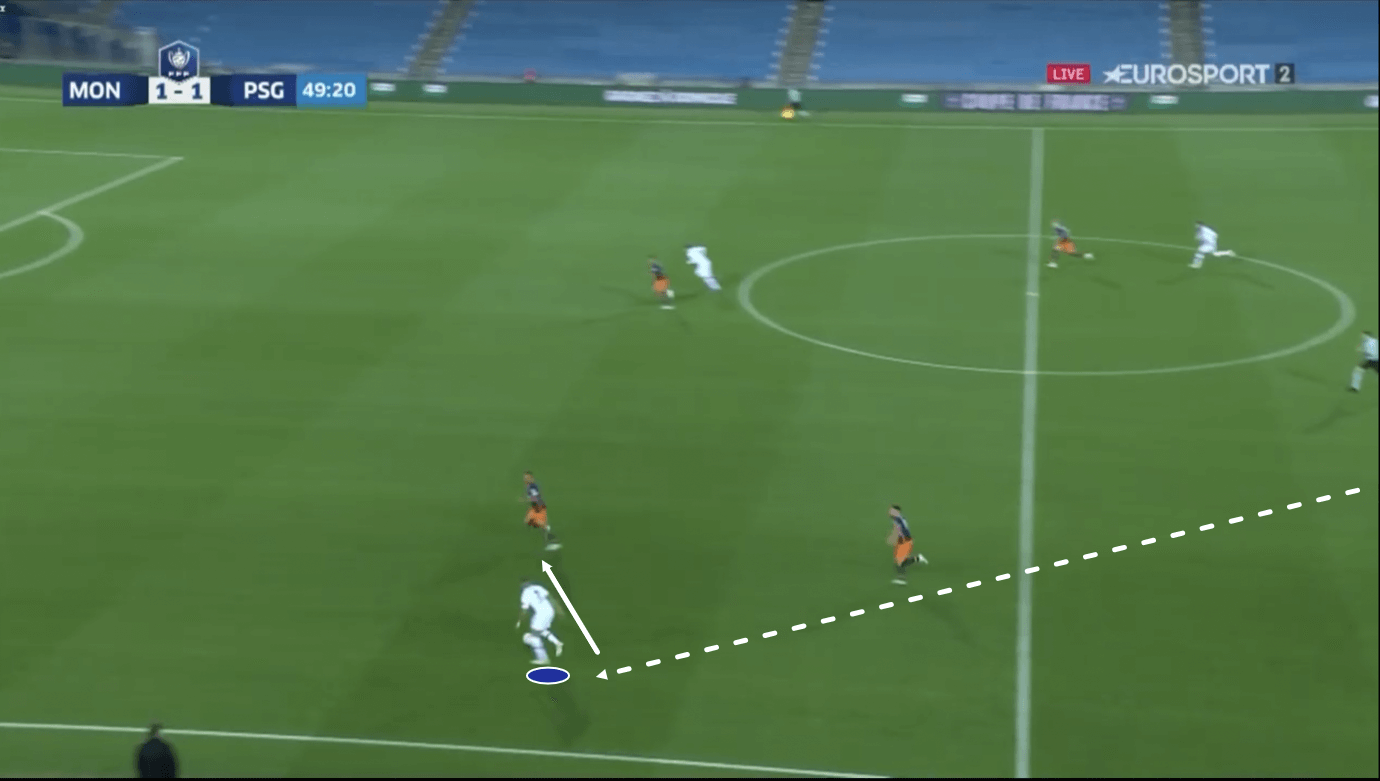
Mbappé loves to pull out onto the left wing during moments of transition, as he likes to get the ball with space ahead of him where he can take a defender on 1v1 – see figure 12. This doesn’t have to just be in transition, however, Mbappé just likes to receive the ball towards the left in such a way that he can move forward, beat a man, and open up his body before shooting. It only makes sense for PSG to accommodate his preference for the left side as he is an elite forward who’s putting up extremely impressive numbers in terms of finishing and whatever they can do to make him more comfortable would surely be beneficial. Additionally, this probably fits well into PSG’s system, with Messi occupying a slightly more withdrawn right forward position.
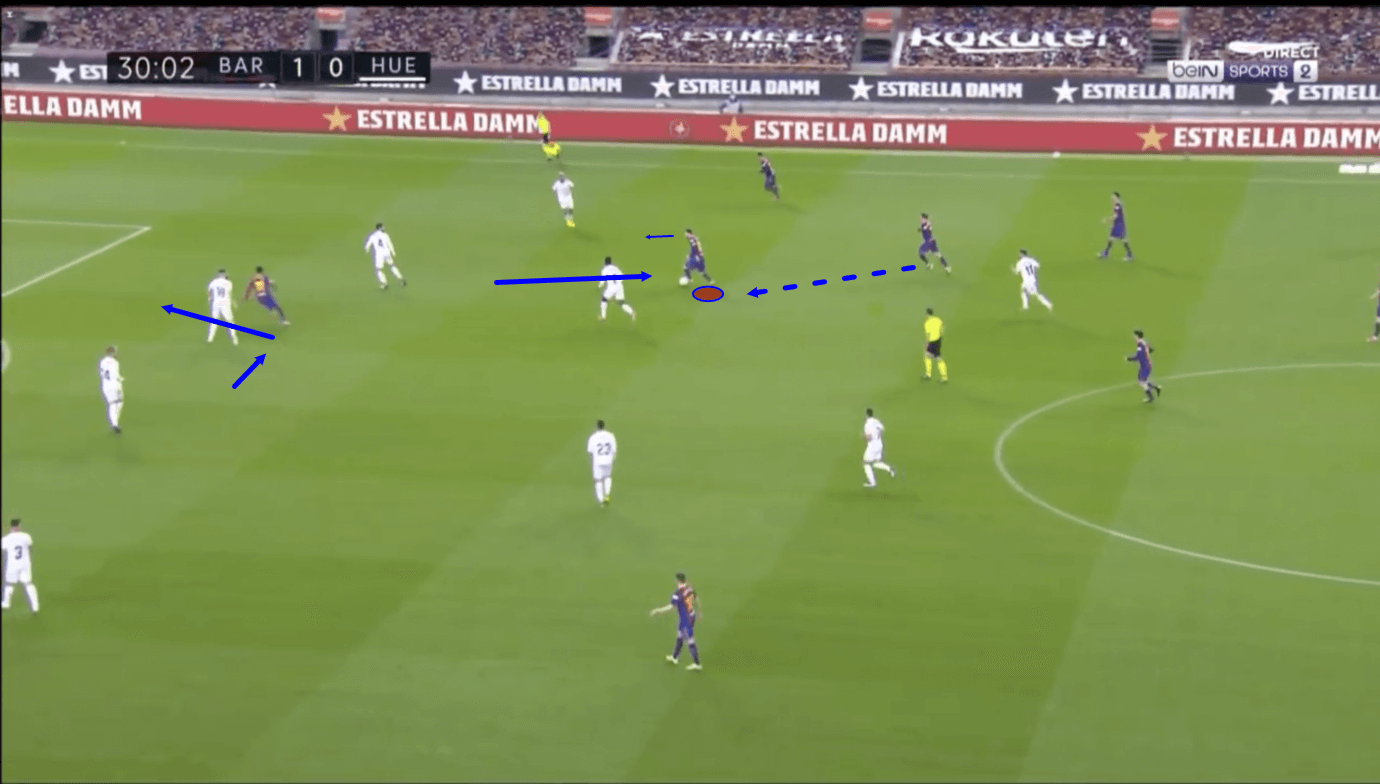
On paper, we see Messi as the ‘10’ in this system but in action, we see him favouring the right, frequently occupying the right half-space or right centre-forward position, as seen in figure 13. The attackers in this team will find space where they like it, occupy that space, and make magic happen there when it’s their turn, and that applies to nobody more than Messi. We all know what he is capable of on the ball – he is a space-invading cheat code. He’ll often drop deep – similar to Neymar and potentially rotating with Di María or Hakimi, finding space centrally where he can carry the ball upfield or pick out a run from Hakimi, Di María, Mbappé or Neymar in behind the opposition.
Having compared Mbappé and his tendency to favour the left to Henry at Arsenal, it seems appropriate to compare Messi to Dennis Bergkamp, who was something between a right forward and a ‘10’ alongside Henry. It will be very interesting to see how the relationship between Messi and Mbappé develops, but they are two great players whose profiles seem like a very good fit for each other, viewing Messi as essentially a right forward and Mbappé as a left forward. Mbappé will frequently provide the movement in behind, terrifying pace, and clinical finishing ability, while Messi will primarily be a playmaker between the lines, finding space and reacting to the movement ahead of him.
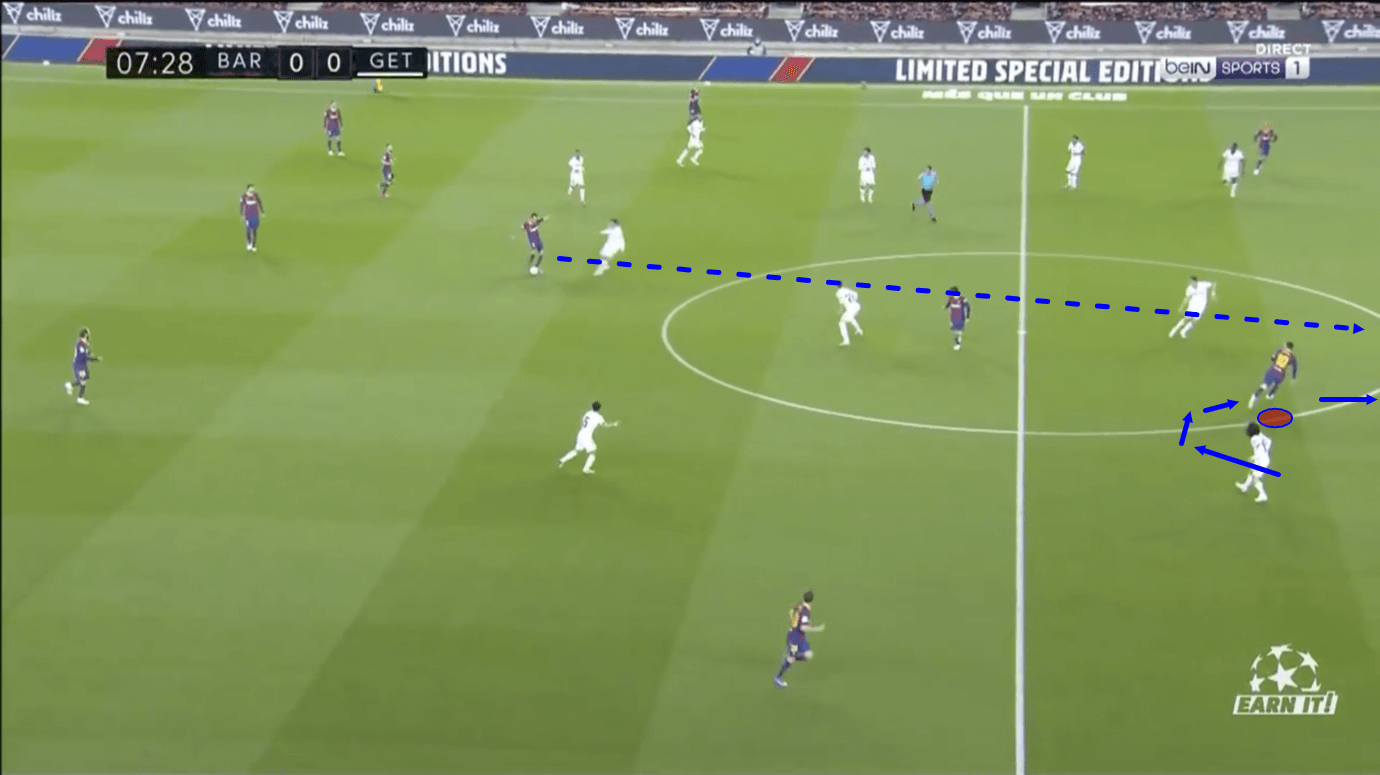
However, an interesting dynamic that could be of great use to PSG is that while Messi will primarily be found dropping between the lines, it’s not totally uncommon to see him playing as a typical 9, making runs in behind the defensive line himself – see figure 14 – and should Mbappé drop off in between the lines on occasion to look for the ball to feet, that could attract a defender and open space for Messi to target with a run in behind, which the deeper-lying playmakers must watch out for, as creating a simple 1v1 with Messi and the goalkeeper is going to result in goals far more often than not.
It’s a different take on the dynamic than you might expect when you think of pairing Mbappé and Messi, but Messi is a genius at exploiting space, while he’s also excellent at bending his runs in behind to accommodate the passer, like in the image above and will react to space opening up in behind as Mbappé drops off, so this could be a really good way of creating a different threat for the opposition on occasion.
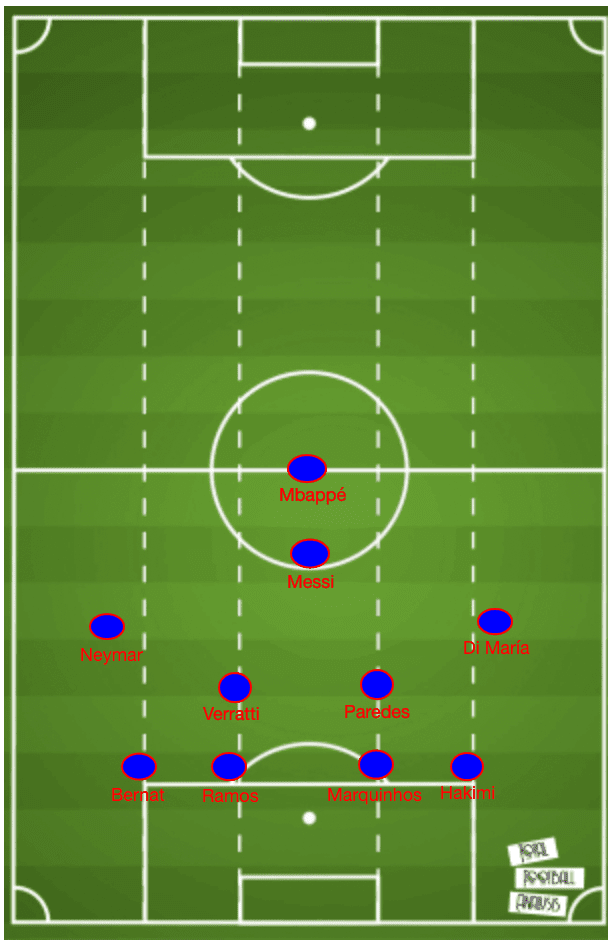
In summary, we think that Pochettino’s side may primarily shape up as seen in figure 15 without the ball, in the 4-2-3-1 shape that he’s favoured throughout his career.
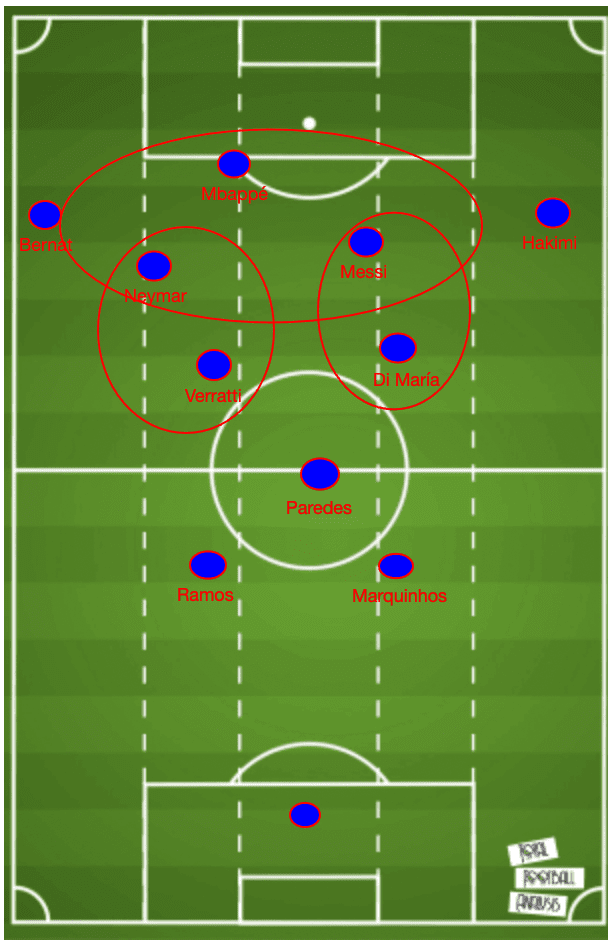
Offensively, we think the team could morph into the 2-3-5 seen in figure 16, with heavy rotations between the players occupying the circled areas. We may see Messi and Neymar drop deep to help with ball progression, particularly when playing against a more stubborn defensive block, which could then lead to rotations with Di María and Verratti, respectively. Meanwhile, the front three here has the potential to be very fluid with a lot of positional interchanges – giving opposition defenders a bit of a nightmare.
Conclusion
In conclusion, we’re excited to see what Pochettino ultimately does with his team and we’re sure the Argentinian tactician will engage in a lot of experimentation to strike the best balance in his squad in terms of personnel and roles. It’s an interesting exercise to put yourself in Pochettino’s shoes right now and think about how these elite players will gel together, so we’re looking forward to seeing the Messi era begin at Le Parc des Princes and observe as the teambuilding actually transpires.

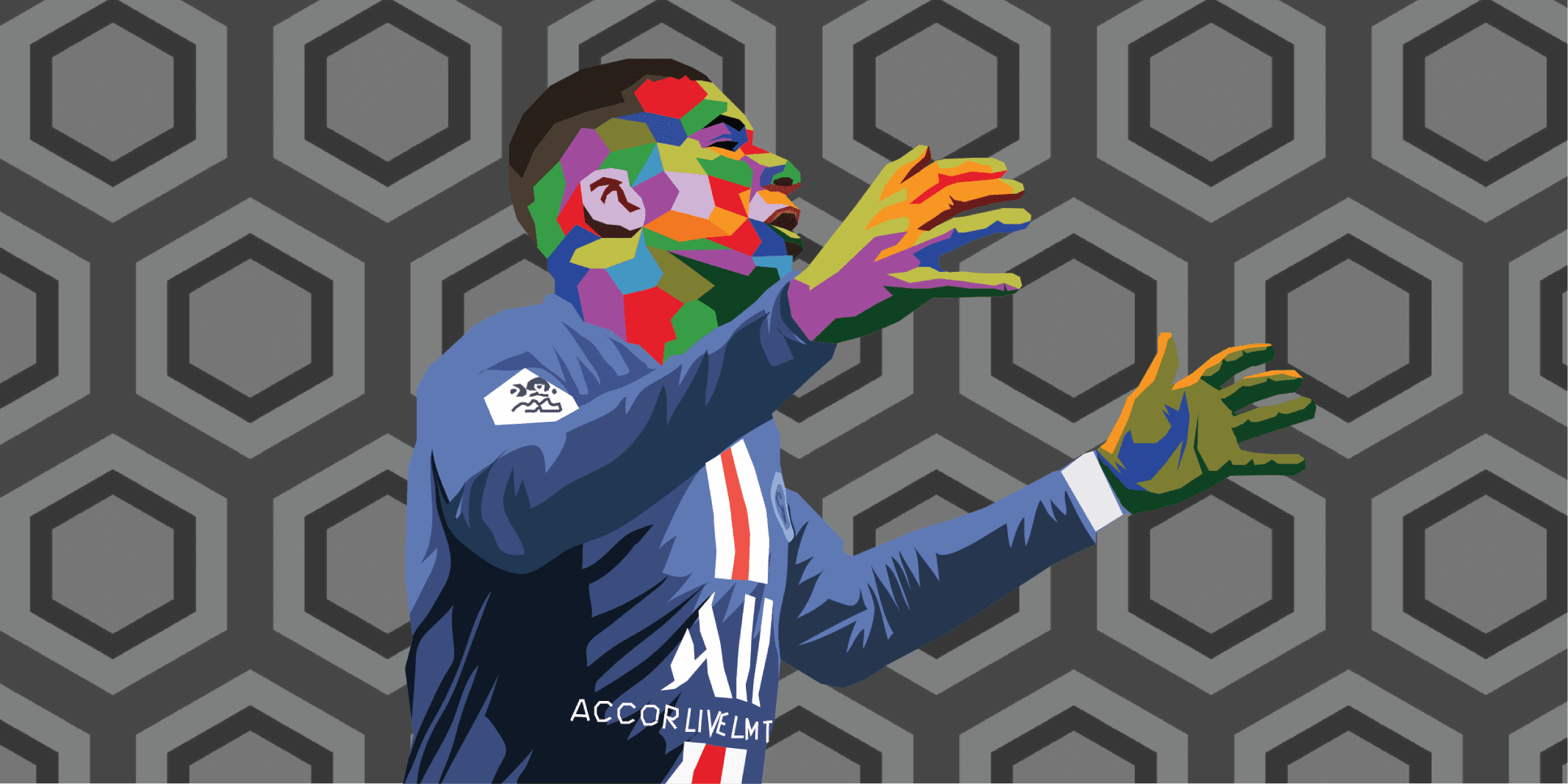



Comments